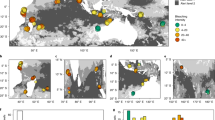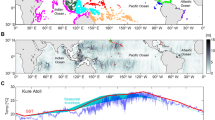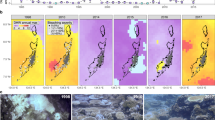Abstract
Increasing sea surface temperatures (SSTs) are predicted to adversely impact coral populations worldwide through increasing thermal bleaching events. Future bleaching is unlikely to be spatially uniform. Therefore, understanding what determines regional differences will be critical for adaptation management. Here, using a cumulative heat stress metric, we show that characteristics of regional SST determine the future bleaching risk patterns. Incorporating observed information on SST variability, in assessing future bleaching risk, provides novel options for management strategies. As a consequence, the known biases in climate model variability and the uncertainties in regional warming rate across climate models are less detrimental than previously thought. We also show that the thresholds used to indicate reef viability can strongly influence a decision on what constitutes a potential refugia. Observing and understanding the drivers of regional variability, and the viability limits of coral reefs, is therefore critical for making meaningful projections of coral bleaching risk.
This is a preview of subscription content, access via your institution
Access options
Access Nature and 54 other Nature Portfolio journals
Get Nature+, our best-value online-access subscription
$29.99 / 30 days
cancel any time
Subscribe to this journal
Receive 12 print issues and online access
$209.00 per year
only $17.42 per issue
Buy this article
- Purchase on Springer Link
- Instant access to full article PDF
Prices may be subject to local taxes which are calculated during checkout



Similar content being viewed by others
References
Hoegh-Guldberg, O. et al. in Vulnerability of Tropical Fisheries and Aquaculture to Climate Change (eds Bell, J. D., Johnson, J. E. & Hobday, A. J.) 251–296 (Secretariat of the Pacific Community, 2011).
Bell, J. D. et al. Mixed responses of tropical Pacific fisheries and aquaculture to climate change. Nat. Clim. Change 3, 591–599 (2013).
Anthony, K. R. N. et al. Operationalizing resilience for adaptive coral reef management under global environmental change. Glob. Change Biol. 21, 48–61 (2015).
Marshall, A. T. & Code, P. Calcification rate and the effect of temperature in a zooxanthellate and an azooxanthellate scleractinian reef coral. Coral Reefs 23, 218–224 (2004).
Glynn, P. W. Coral reef bleaching: facts, hypotheses and implications. Glob. Change Biol. 2, 495–509 (1996).
Hoegh-Guldberg, O. Climate change, coral bleaching and the future of the world’s coral reefs. Mar. Freshw. Res. 50, 839–866 (1999).
Cooper, T. F., De’ath, G., Fabricius, K. E. & Lough, J. M. Declining coral calcification in massive Porites in two nearshore regions of the northern Great Barrier Reef. Glob. Change Biol. 14, 529–538 (2008).
Cantin, N. E., Cohen, A. L., Karnauskas, K. B., Tarrant, A. M. & McCorkle, D. C. Ocean warming slows coral growth in the central Red Sea. Science 329, 322–325 (2010).
Glynn, P. W. Coral reef bleaching: ecological perspectives. Coral Reefs 12, 1–17 (1993).
Heron, S. F., Maynard, J. A., van Hooidonk, R. & Eakin, C. M. Warming trends and bleaching stress of the world’s coral reefs 1985–2012. Sci. Rep. 6, 38402 (2016).
Hughes, T. P. et al. Global warming and recurrent mass bleaching of corals. Nature 543, 373–377 (2017).
Wilkinson, C. Status of Coral Reefs of the World: 2008 (Global Coral Reef Monitoring Network and Reef and Rainforest Research Center, 2008).
Gattuso, J.-P. et al. Contrasting futures for ocean and society from different anthropogenic CO2 emissions scenarios. Science 349, 6243 (2015).
Donner, S. D., Skirving, W. J., Little, C. M., Oppenheimer, M. & Hoegh-Gulberg, O. Global assessment of coral bleaching and required rates of adaptation under climate change. Glob. Change Biol. 11, 2251–2265 (2005).
Meissner, K. J., Lippmann, T. & Gupta, a. S. Large-scale stress factors affecting coral reefs: open ocean sea surface temperature and surface seawater aragonite saturation over the next 400 years. Coral Reefs 31, 309–319 (2012).
Frieler, K. et al. Limiting global warming to 2 °C is unlikely to save most coral reefs. Nat. Clim. Change 2, 1–6 (2012).
van Hooidonk, R., Maynard, J. a. & Planes, S. Temporary refugia for coral reefs in a warming world. Nat. Clim. Change 3, 508–511 (2013).
Sutherland, W. J. et al. One hundred questions of importance to the conservation of global biological diversity. Conserv. Biol. 23, 557–567 (2009).
Xie, S.-P. et al. Global warming pattern formation: sea surface temperature and rainfall*. J. Clim. 23, 966–986 (2010).
Donner, S. D. An evaluation of the effect of recent temperature variability on the prediction of coral bleaching events. Ecol. Appl. 21, 1718–1730 (2011).
Eakin, C. M., Lough, J. M. & Heron, S. F. in Coral Bleaching: Patterns, Processes, Causes and Consequences (eds van Oppen, M. J. H. & Lough, J. M.) 41–67 (Springer, 2009).
Liu, G. et al. NOAA Coral Reef Watch’s next-generation 5 km satellite coral bleaching thermal stress monitoring. 29, 27–29 (2014).
Heron, S. et al. Validation of reef-scale thermal stress satellite products for coral bleaching monitoring. Remote Sens. 8, 59 (2016).
Eakin, C. M., Liu, G., Chen, M. & K, A. Ghost of bleaching future: seasonal outlooks from NOAA’s operational climate forecast system. Proc. 12th Int. Coral Reef Symp. (2012)http://www.icrs2012.com/proceedings/manuscripts/ICRS2012_10A_1.pdf
Logan, C. a., Dunne, J. P., Eakin, C. M. & Donner, S. D. Incorporating adaptive responses into future projections of coral bleaching. Glob. Change Biol. 20, 125–139 (2014).
Brown, J. N., Langlais, C. & Maes, C. Zonal structure and variability of the Western Pacific dynamic warm pool edge in CMIP5. Clim. Dynam. 42, 3061–3076 (2014).
Bellenger, H., Guilyardi, E., Leloup, J., Lengaigne, M. & Vialard, J. ENSO representation in climate models: from CMIP3 to CMIP5. Clim. Dynam. 42, 1999–2018 (2014).
Wigley, T. M. L. The effect of changing climate on the frequency of absolute extreme events. Climatic Change 97, 67–76 (2009).
van Hooidonk, R. & Huber, M. Effects of modeled tropical sea surface temperature variability on coral reef bleaching predictions. Coral Reefs 31, 121–131 (2012).
Kleypas, J. a., Danabasoglu, G. & Lough, J. M. Potential role of the ocean thermostat in determining regional differences in coral reef bleaching events. Geophys. Res. Lett. 35, L03613 (2008).
Freeman, L. a., Miller, A. J., Norris, R. D. & Smith, J. E. Classification of remote Pacific coral reefs by physical oceanographic environment. J. Geophys. Res. 117, C02007 (2012).
Eakin, C. M. et al. Global coral bleaching 2014–2017: status and an appeal for observations. Reef Encount. 31, 20–26 (2016).
DiNezio, P. N. et al. Climate response of the equatorial Pacific to global warming. J. Clim. 22, 4873–4892 (2009).
Baker, A. C., Glynn, P. W. & Riegl, B. Climate change and coral reef bleaching: an ecological assessment of long-term impacts, recovery trends and future outlook. Estuar. Coast. Shelf Sci. 80, 435–471 (2008).
Selig, E. R., Casey, K. S. & Bruno, J. F. Temperature-driven coral decline: the role of marine protected areas. Glob. Change Biol. 18, 1561–1570 (2012).
Carilli, J., Donner, S. D. & Hartmann, A. C. Historical temperature variability affects coral response to heat stress. PLoS ONE 7, e34418 (2012).
Oliver, T. a. & Palumbi, S. R. Do fluctuating temperature environments elevate coral thermal tolerance? Coral Reefs 30, 429–440 (2011).
Collins, M. et al. The impact of global warming on the tropical Pacific Ocean and El Niño. Nat. Geosci. 3, 391–397 (2010).
Cai, W. et al. Increasing frequency of extreme El Niño events due to greenhouse warming. Nat. Clim. Change 4, 111–116 (2014).
Wittenberg, A. T. Are historical records sufficient to constrain ENSO simulations? Geophys. Res. Lett. 36, L12702 (2009).
Guilyardi, E. et al. Understanding El Niño in ocean–atmosphere general circulation models: progress and challenges. Bull. Am. Meteorol. Soc. 90, 325–340 (2009).
Lima, F. P. & Wethey, D. S. Three decades of high-resolution coastal sea surface temperatures reveal more than warming. Nat. Commun. 3, 704 (2012).
Bruno, J. F. & Selig, E. R. Regional decline of coral cover in the Indo-Pacific: timing, extent, and subregional comparisons. PLoS ONE 2, e711 (2007).
Hoegh-Guldberg, O. et al. Coral reefs under rapid climate change and ocean acidification. Science 318, 1737–1742 (2007).
Anthony, K. R. N., Kline, D. I., Diaz-Pulido, G., Dove, S. & Hoegh-Guldberg, O. Ocean acidification causes bleaching and productivity loss in coral reef builders. Proc. Natl Acad. Sci. USA 105, 17442–17446 (2008).
Wooldridge, S., Heron, S., Brodie, J., Done, T. & Masiri, I. Excess seawater nutrients, enlarged algal symbiont densities and bleaching sensitive reef locations: 2. A regional-scale predictive model for the Great Barrier Reef, Australia. Mar. Pollut. Bull. 114, 343–354 (2016).
Van Woesik, R., Sakai, K., Ganase, a. & Loya, Y. Revisiting the winners and the losers a decade after coral bleaching. Mar. Ecol. Prog. Ser. 434, 67–76 (2011).
Stuart-Smith, R. D., Edgar, G. J., Barrett, N. S., Kininmonth, S. J. & Bates, A. E. Thermal biases and vulnerability to warming in the world’s marine fauna. Nature 528, 88–92 (2015).
Middlebrook, R., Hoegh-Guldberg, O. & Leggat, W. The effect of thermal history on the susceptibility of reef-building corals to thermal stress. J. Exp. Biol. 211, 1050–1056 (2008).
Evenhuis, C., Lenton, A., Cantin, N. E. & Lough, J. M. Modelling coral calcification accounting for the impacts of coral bleaching and ocean acidification. Biogeosciences 12, 2607–2630 (2015).
Reynolds, R. W. et al. Daily high-resolution-blended analyses for sea surface temperature. J. Clim. 20, 5473–5496 (2007).
Glynn, P. W. & D’Croz, L. Experimental evidence for high temperature stress as the cause of El Niño-coincident coral mortality. Coral Reefs 8, 181–191 (1990).
Berkelmans, R. & Willis, B. L. Seasonal and local spatial patterns in the upper thermal limits of corals on the inshore Central Great Barrier Reef. Coral Reefs 18, 219–228 (1999).
Liu, G., Strong, A. E. & Skirving, W. Remote sensing of sea surface temperatures during 2002 Barrier Reef coral bleaching. Eos 84, 137–144 (2003).
Heron, S. F. et al. Summer hot snaps and winter conditions: modelling white syndrome outbreaks on Great Barrier Reef corals. PLoS ONE 5, e12210 (2010).
Heron, S. et al. Identifying oceanic thermal anomalies in the coral triangle region. Proc. 12th Int. Coral Reef Symp. (2012); http://www.icrs2012.com/proceedings/manuscripts/ICRS2012_17D_1.pdf
Maynard, J. et al. Projections of climate conditions that increase coral disease susceptibility and pathogen abundance and virulence. Nat. Clim. Change 5, 688–694 (2015).
Donner, S. D. Coping with commitment: projected thermal stress on coral reefs under different future scenarios. PLoS ONE 4, e5712 (2009).
Eakin, C. M. et al. Caribbean Corals in crisis: record thermal stress, bleaching, and mortality in 2005. PLoS ONE 5, e13969 (2010).
Sheppard, C. R. C. Predicted recurrences of mass coral mortality in the Indian Ocean. Nature 425, 294–297 (2003).
Teneva, L. et al. Predicting coral bleaching hotspots: the role of regional variability in thermal stress and potential adaptation rates. Coral Reefs 31, 1–12 (2012).
Halford, A., Cheal, A. J., Ryan, D. & Williams, D. M. Resilience to large-scale disturbance in coral and fish assemblages on the Great Barrier Reef. Ecology 85, 1892–1905 (2004).
Taylor, K. E., Stouffer, R. J. & Meehl, G. A. An overview of CMIP5 and the experiment design. Bull. Am. Meteorol. Soc. 93, 485–498 (2011).
van Vuuren, D. P. et al. The representative concentration pathways: an overview. Climatic Change 109, 5–31 (2011).
Commonwealth Scientific and Industrial Research Organization (CSIRO) Bureau of Meteorology (BoM) Climate Change in the Pacific: Scientific Assessment and New Research Vol. 2, Country Reports 13–23 (CSIRO and BOM, 2011).
Smith, I. N., Moise, A. F. & Colman, R. a. Large-scale circulation features in the tropical western Pacific and their representation in climate models. J. Geophys. Res. 117, 1–15 (2012).
Brown, J. N. et al. Implications of CMIP3 model biases and uncertainties for climate projections in the western tropical Pacific. Climatic Change 119, 147–161 (2013).
Brown, J. R., Moise, A. F. & Colman, R. A. The South Pacific Convergence Zone in CMIP5 simulations of historical and future climate. Clim. Dynam. 41, 2179–2197 (2013).
Grose, M. R. et al. Assessment of the CMIP5 global climate model simulations of the western tropical Pacific climate system and comparison to CMIP3. Int. J. Climatol. 34, 3382–3399 (2014).
Jourdain, N. C. et al. The Indo-Australian monsoon and its relationship to ENSO and IOD in reanalysis data and the CMIP3/CMIP5 simulations. Clim. Dynam. 41, 3073–3102 (2013).
Ainsworth, T. D. et al. Climate change disables coral bleaching protection on the Great Barrier Reef. Science 352, 338–342 (2016).
Acknowledgements
We thank the World Climate Research Programs Working Group on Coupled Modelling for their roles in making available the CMIP5 multi-model data sets. This work was supported by the NCI National Facility. This research was conducted with the support of the Pacific-Australia Climate Change Science and Adaptation Planning Program funded by AusAID in collaboration with the Department of Climate Change and Energy Efficiency, and delivered by the Bureau of Meteorology and the Commonwealth Scientific and Industrial Research Organisation (CSIRO). The manuscript contents are solely the opinions of the authors and do not constitute a statement of policy, decision, or position on behalf of NOAA or the US government.
Author information
Authors and Affiliations
Contributions
All authors contributed to the design and writing of the paper. C.E.L. performed the research. C.E.L. and A.L. analysed the data.
Corresponding author
Ethics declarations
Competing interests
The authors declare no competing financial interests.
Supplementary information
Supplementary Information
Supplementary Information (PDF 773 kb)
Rights and permissions
About this article
Cite this article
Langlais, C., Lenton, A., Heron, S. et al. Coral bleaching pathways under the control of regional temperature variability. Nature Clim Change 7, 839–844 (2017). https://doi.org/10.1038/nclimate3399
Received:
Accepted:
Published:
Issue Date:
DOI: https://doi.org/10.1038/nclimate3399
This article is cited by
-
Systematic review of the uncertainty of coral reef futures under climate change
Nature Communications (2024)
-
High-resolution in situ thermal metrics coupled with acute heat stress experiments reveal differential coral bleaching susceptibility
Coral Reefs (2022)
-
A new record for a massive Porites colony at Ta’u Island, American Samoa
Scientific Reports (2020)
-
Resilience of Central Pacific reefs subject to frequent heat stress and human disturbance
Scientific Reports (2019)
-
Three decades of heat stress exposure in Caribbean coral reefs: a new regional delineation to enhance conservation
Scientific Reports (2019)



